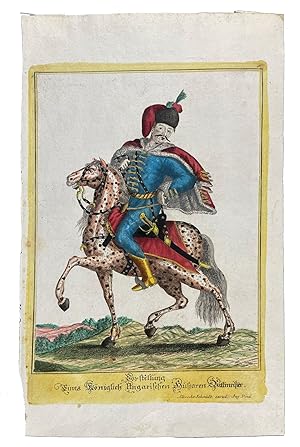Beschreibung
(14 1/4 x 8 1/2 inches). Folio. (14 1/4 x 8 1/2 inches) 12 hand-coloured copper-plate engravings heightened with silver and gold on rectos of thick handmade laid paper bound into a slim volume. Each plate has an engraved title, several with accompanying humorous 4-line rhyming verses in German and Latin. Quarter-bound to style in contemporary calf with gilt-detailing in six compartments, a red Morocco letter-piece in the second compartment gilt, period marbled paper boards. A rare collection of 12 engravings from the War of Austrian Succession, Schmidt's handsome martial portraits depict the regalia and weaponary of the war's main players, from Prussian Hussars and Royal Hungarian infantrymen to the Slavonian Pandurs and their corrupt leader, Baron Franz von der Trenck. Albrecht Schmidt's typological watercolors date from the War of Austrian Secession, an eight-year war in Central Europe over the right of Maria Theresa to succeed her father Emperor Charles VI as the head of the Habsburg Monarchy. Prussia was the Monarchy's main antagonist in the war, but all of the major European powers were eventually drawn into the struggle. Plate 8, which depicts a "Prussian knight" on horseback, cloaked in black and wearing a death's head as if a Horseman of the Apocalypse, shows on which side of the war Schmidt likely stood. The painting is an effective, early piece of modern war propaganda. Baron Franz von der Trenck, pictured in Plate 12, became famous during the War of Succession as the leader of a unit of Pandurs, or paramilitary troops, who employed guerrilla tactics and surprise hit-and-run actions, and into which he recruited experienced Croatian mercenaries. Trenck's Pandurs became infamous for the brutal atrocities they committed on civilian populations. At the Battle of Soor, Trenck and his irregulars plundered when they should have been fighting and were accused of allowing Prussia's King Frederick the Great to escape. Trenck was later court-martialed in Vienna by the Empress and convicted of selling commissions to his officers without her permission, of punishing his men without heed of the military code, and of drawing pay and allowance for fictitious men. Trenck spent the rest of his life in captivity in Brno. Schmidt was a prolific German printmaker and publisher of popular prints, religious imagery, and playing cards. Schmidt, who was born in Ulm, lived in Augsburg, then a free Imperial city of the Habsburg monarchy with a strong economy that was a leading center of book publishing in the German language. His woodcuts and engravings, often hand-colored, are in the collections of the Metropolitan Museum of Art, the Victoria and Albert Museum, the Princely Collections of Liechtenstein, and the Philadelphia Museum of Art. Plate titles: 1. Ein Königle Ungarischer Hanack, wie er zu Felde geht. [A royal Hungarian hanack going into the field.] 2. Ein Königle Ungarischer Talpatschen Tambour zu Pferd. [A royal Hungarian infantry drummer on horseback.] 3. Reginae Hungariae Majestatis, non nullorum Husaronum agminum constituti Ducis, de Menzel, repraesentatio. [A representative of Her Majesty, the Queen of Hungary, not of any Hussar troops appointed by Duke de Menzel.] 4. Ein Königlicher Ungarischer Tolpatschen Fendrich un Feld. [A royal Hungarian infantry standard-bearer in the field.] 5. Ein Königle Ungarischer Sfangen-Reiter. [A royal Hungarian lancer on horseback.] 6. Se. Hochgraefle Excellenz, Herr Baron von Berenklau, Königlich Ungarischer Comandirender General en Chef der Husaren und Panduren. [Senior High Count, Baron von Berenklau, the royal Hungarian Commanding General in charge of the Hussars and Pandurs.] 7. Vorstellung eines commandirenden Dalpatschen Obristen. [Image of a commanding infantry colonel.] 8. Borussus Eques | Preussischer Hussar: Levis armaturae et nigri in dumenti, pro ligno hominus demortui crania gerens. [A Prussian knight in light armor and a black cloak, wearing the skull of a dead man for an emblem.] 9. Bestandsnummer des Verkäufers 39351
Verkäufer kontaktieren
Diesen Artikel melden
![]()




